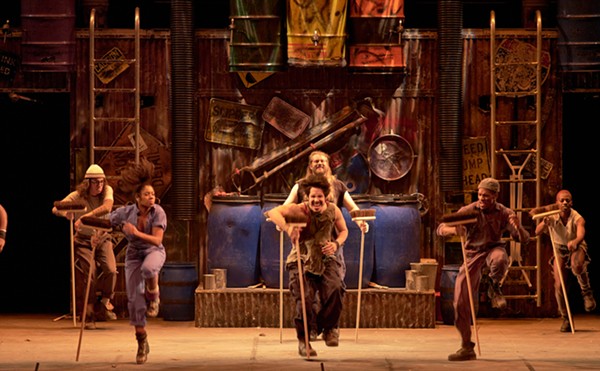NEW
Artist as Quiltmaker XIII — Crafting may be a hip hobby for twentysomethings, but only a hardcore crafter goes beyond the usual projects — jewelry fashioned from PBR bottle caps, crocheted iPod cozies, etc. — to take up quilting. The handiwork of such diehard crafty folk from across the country is on display for this biennial juried exhibition, and it sets the standard for those stocking up on fabric scraps. Here, visitors should be happy to note, quilters avoid common symmetrical blocks, instead making imaginative plays on the traditional bedcovering — moves that involve the same kind of design decisions about pattern, color, and texture made by painters and other less craft-y artists. As a result, these quilts are not functional; they're the expressions of individuals. Rebekka Seigel, for one, uses old yearbook photos to make a political statement in "The Real Cost of War: Class of 1911" and "The Real Cost of War: Class of 1966," in which she recreates the smiling faces of high-school seniors before their lives were presumably altered by the realities of warfare. Molly Elkind's "13 Ways of Looking at Dodd's Creek," meanwhile, features tiny strips of fabric, covered with whirling patterns of stitches and beads, which resemble the movement of running water. With its intimate size and intricate details, Elkind's quilt comes across as a personalized document. Through August 2 at the Firelands Association for the Visual Arts Gallery, 39 S. Main St., Oberlin, 440-774-7158. — Theresa Bembnister
ONGOING
Bittersweet — The title implies pleasure mingled with pain and conjures up associations with memory. And that's just what Margot Ecke's "archive" addresses. Ecke collects an assortment of miscellaneous objects — a used German World War II-era glass eye, Cuban postage stamps, a pinecone — and places them in tiny boxes decorated with pink and blue plaid. She arranges these packages on a table, surrounding an old-school typewriter — the one used, presumably, to transcribe the poetry that's stuck to the inside of the box lids. An exhibition checklist also details how Ecke landed each object, with methods as mundane as eBay and as personal as raiding Grandma's sewing box. The delicate packaging and hints at history spark feelings of nostalgia: These items were important to somebody somewhere at some time, and viewers are invited to fill in those blanks. The installation is paired with intaglio prints by Ecke's fellow University of Georgia printmaking professor Shelly DiCello, whose chosen medium also references memory. To create an intaglio print, an artist scratches grooves into a metal plate, which is inked and pressed against a piece of paper to make an image. Words and numbers appear throughout her prints, but are rarely completely legible beneath layers of lines and gray tones. DiCello's aesthetic is that of lyrical documentation, a tentative revelation of visual responses to ideas and emotions. Through June 14 at Zygote Press, Inc., 1410 E. 30th St., Cleveland, 216-621-2900. — Bembnister
"Hey!" William Schwartz: New Sculptures and Op Art — The most commonly uttered phrase in art galleries is probably "I could do that," followed by "My kid could do that." And guess what? You probably could make the stuff in William Schwartz's exhibition; "Awakening of Intelligence," for one, is just a cutout circle, painted the same color as the white wall behind it. But Schwartz's work seems to be more about the idea behind the art than the object itself. The artist describes it as "op art," a movement that has deep roots in Northeast Ohio. Artists Ed Mieczkowski, Francis Hewitt, and Ernst Benkert formed the Anonima Group in Cleveland in 1960 and went on to play a seminal role in the movement's development with longtime Cleveland Institute of Art professor Julian Stanczak. The idea of op art is to challenge how people understand what they see. It often features optical illusions of three-dimensionality on a flat picture plane. But Schwartz's work isn't exactly op art. His two-dimensional works and sculptures are concerned with things other than pure form — patriotism, masculinity, and art history. "Fresh Windows #1" consists of American flags turned on their sides and repeated until the pattern resembles the windows of an apartment building. Elsewhere, he uses obvious phallic references such as golf tees, nails, balls, and titles such as "[Thanks] Viagra." So, while he claims to be making op art, Schwartz appears to be uninterested in the science and illusion behind what people see. He wants them to think about what they perceive, not how they perceive it. Through June 14 at Arts Collinwood Gallery, 15605 Waterloo Rd., Cleveland, 216-692-9500. — Bembnister
Through Wilderness — Philadelphia artist Hilary White's artwork is a mash-up of apparent opposites. Her sculptural paintings, on cut wood panel and plastic, are steeped in religious symbolism and conveyed through an immaculately crafted punk aesthetic. And you don't have to be a theologian to appreciate the creepiness of the ascending doves or circlets of golden rays that appear throughout her work. White uses this Christian symbolism to address a spiritual or mental quest; she writes that throughout the Bible, the wilderness is a place of both trial and renewal. But her paintings are full of secular symbols too. Dump trucks, toppled pine trees, and wood-chippers serve as reminders of today's shrinking wilderness, while bears and vultures are depicted feasting on smaller animals, reinforcing the cycle of life and death — a theme also seen in images representing Christ's passion, such as the crown of thorns. Perhaps most impressive is White's masterful combination of dozens of tiny, delicate three-dimensional pieces, collaged together to create brilliantly colored, unified wall-hanging artworks. White, who graduated last year from the Savannah College of Art and Design, presents a body of paintings that reflects a maturity, attention to detail, and conceptual richness not commonly found in the work of artists so early in their career. Through June 15 at Front Room, 3615 Superior Ave. #4203-A, Cleveland, 216-534-6059. — Bembnister












